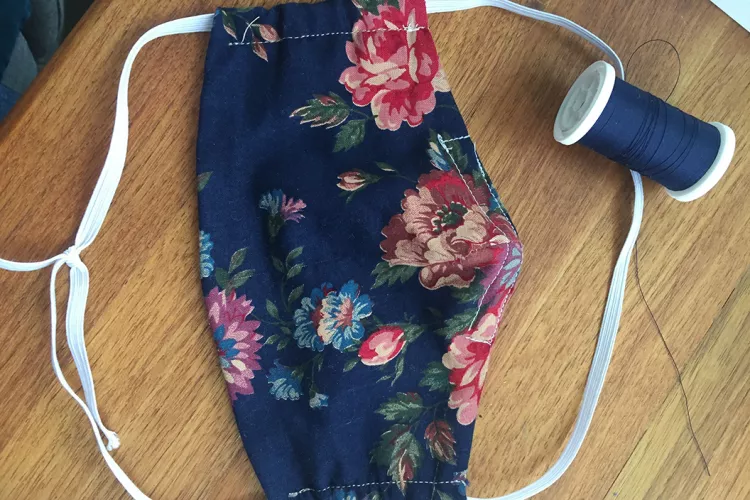Tara Webb '94 Helps Mask-Making Efforts to Combat Pandemic

As Costume Shop manager at Swarthmore’s Lang Performing Arts Center, Tara Webb ’94 is accustomed to outfitting students for their theater and dance productions. These days, though, Webb is outfitting a broader community, organizing mask-making efforts to aid against the spread of COVID-19.
Beyond sewing masks herself from her home in Swarthmore, Webb has been a resource for students, staff members, and others hoping to lend a hand in response to the pandemic. After fielding numerous calls from crafters looking for advice, she created a comprehensive guide to mask-making, complete with best practices, suggested materials, and sewing patterns for a range of skill levels. But she soon realized she could be even more helpful by coordinating where to donate.
“When this all first started, none of the local hospitals were taking home-sewn masks, because it’s a whole big process and they were overwhelmed,” she says. But with recent recommendations from the Centers for Disease Control and Prevention that all Americans should be wearing masks in public, the need has grown exponentially, “with now about 20 organizations nationally, and at least three groups locally that I’ve connected with, seeking mask donations.”
Most of these groups are united through the #masks4all movement, which recognized early that face coverings could be helpful in flattening the curve, she says. For her part, though, Webb has been focusing on the hyperlocal, creating a cache of masks for the College community and for her neighbors in the borough.
“The big project now is, how do I connect people so that we can generate masks for the people that are still on campus?” she says. The hope is to quickly create 600 of them for Swarthmore’s essential workers.
These face coverings aren’t difficult to make, Webb says: All that’s needed is a fabric that can stand high heat, preferably with a high cotton content, and something that can attach the mask to the head, such as elastic or even shoelaces. But they do take some time: Webb, who’s highly skilled with a sewing machine, can finish roughly six in an hour and a half.
Thankfully, about 10 nearby students have volunteered to help out — including Chun Wang ’21, Rebecca Lin ’22, and Gwyneth Fletcher ’22 — with the MakerSpace teams from Swarthmore and Haverford each lending two sewing machines to the cause. About 20 faculty and staff members have stepped up, too, so Webb created a drop-off point where masks can be donated and later sanitized for distribution.
“My family in China has been updating me on the effective use of face masks,” says Wang, a medical anthropology special major from Beijing, China, who was unable to return home during the pandemic. “Especially for our essential staff on campus, I’m very grateful for their support of our well-being during this challenging time. I’m excited that I can thank them by sewing some masks.”
Through the fear and uncertainty surrounding the coronavirus, Webb has been moved by the acts of humanity and compassion that have emerged at Swarthmore and elsewhere, and the ability for communities to come together to help one another. For her, organizing has been “a little bit of a balm, because I’m doing something for other people. You know, I’m not a medical practitioner, but at least I can do this. That’s a good feeling.”
“While, of course, I’ve gotten depressed during the pandemic and I’ve gone through the whole cycle of emotions,” she adds, “I absolutely feel like there's some really good things coming out of this.”

So you want to make a mask of your own?
When it comes to mask-making, “it doesn’t have to be complicated, and we don’t have to overthink it,” says Webb. “It doesn’t matter what style it is, it doesn’t matter if you have an innovative pattern — people need masks. Just keep making them. They’ll get used.”
Here, Webb offers some key tips and suggestions for sewing a mask — for personal use or to give away:
- Use a fabric that can stand high heat, with a high cotton content or a polyester/cotton mix. “Cotton T-shirts work pretty well,” Webb says, “but not as well as, say, a pillowcase or cotton sheet. What they don’t recommend is a fabric that’s more breathable, unfortunately.”
- Elastic can be tough to find right now, so get creative with how the mask attaches to the head by making your own ties or using string or shoelaces.
- Find a pattern that fits your skill level. “There’s more designery patterns if you’re a more accomplished sewer,” says Webb, “but there’s also masks that are just squares of fabric that are gathered at the sides and tied around the head. And that’s totally fine.”
- If you intend to donate to an organization, Webb adds, “a lot of the locations are specific about the patterns they want, so just check with where you’re donating to. They’ll be able to direct you a little bit more specifically.”
- If you encounter a problem with your sewing machine, contact Webb — she can help to diagnose the issue remotely via Zoom. “One of the exciting things for me about the mask-making,” Webb says, “is that it’s highlighting the fact that sewing is an important thing to know. Having people be excited about their sewing machines that are in their closets and excited about this community action that involves sewing — it reminds me of victory gardens in the war.”



